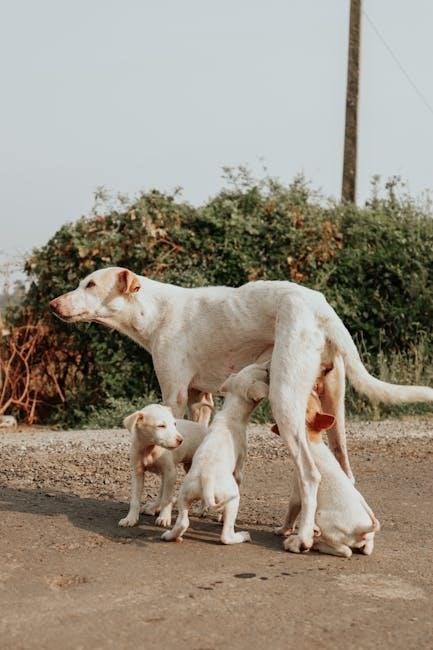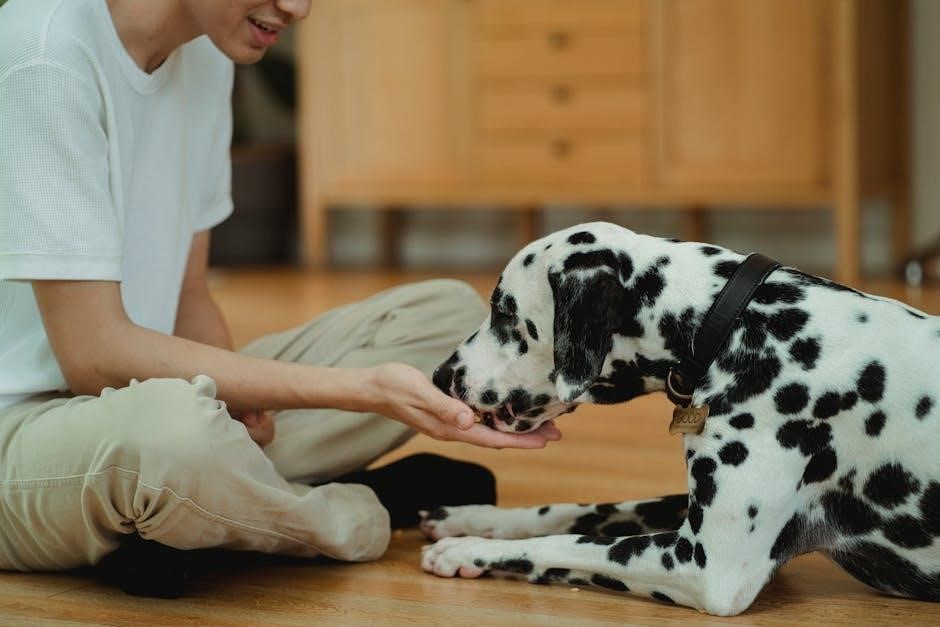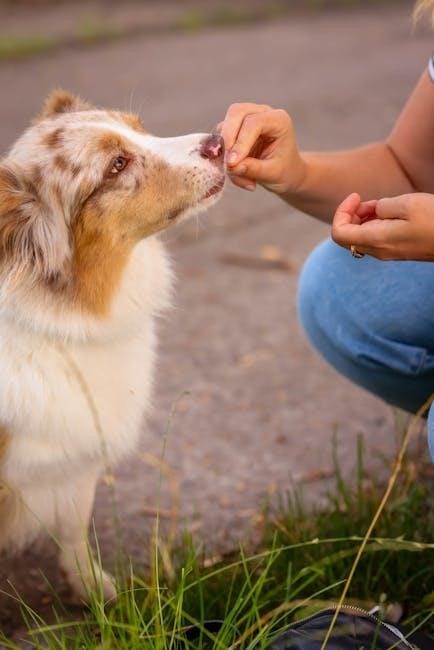Proper feeding is crucial for Great Dane puppies to ensure healthy growth and prevent issues like bloat or joint problems. A balanced, nutrient-rich diet and regular feeding schedule are essential for optimal development. Avoid overfeeding to maintain a healthy weight and support long-term well-being. Consistency and quality in their diet lay the foundation for a thriving adulthood.

Essential Nutrients for Great Dane Puppies
Great Dane puppies require high-quality protein, balanced fats, and complex carbohydrates for growth. Essential nutrients include calcium, phosphorus, and vitamins for bone development and overall health. Avoid fillers and ensure meals are nutrient-dense, with real meat as the primary ingredient.
2.1. High-Quality Protein Sources
High-quality protein sources are vital for Great Dane puppies to support muscle growth and development. Chicken, beef, turkey, lamb, duck, and eggs are excellent choices, providing essential amino acids. These proteins should be the primary ingredients in their diet, ensuring optimal growth without excess fat. Whole meats or meat meals are preferred over by-products, which may lack nutritional value. A diet rich in real animal-based proteins helps build strong muscles and supports overall health, fostering a robust foundation for their large stature. Avoid plant-based proteins as primary sources, as they may not provide the necessary amino acids for proper development.
2.2. Balanced Fats and Carbohydrates
Balanced fats and carbohydrates are essential for Great Dane puppies, providing energy and supporting overall growth. Fats, particularly from animal sources, aid in vitamin absorption and maintaining healthy skin and coat. Carbohydrates, such as whole grains like brown rice, oats, and barley, offer sustained energy and fiber for digestion. Properly balanced fats and carbs help prevent obesity while supporting joint health. Avoid excessive fat content to minimize the risk of weight-related issues. Whole, unprocessed ingredients are preferable to ensure nutritional value. A balanced mix of fats and carbs supports vitality and development, keeping your Great Dane puppy energetic and healthy. Always choose a diet tailored to large breeds to meet their specific needs.
2.3. Vitamins and Minerals
Vitamins and minerals are vital for Great Dane puppies to support growth, immune function, and overall health. Essential nutrients like calcium and phosphorus are crucial for bone development, while Vitamin D aids in calcium absorption. Vitamin E supports skin health and immune function, and B vitamins are important for energy metabolism. Minerals like zinc and selenium play roles in immune support and antioxidant defenses. A balanced diet ensures these nutrients are provided in the right proportions, preventing deficiencies. Excess or deficiency can lead to health issues, so a well-formulated, large-breed-specific diet is recommended. These nutrients work together to promote strong bones, healthy tissues, and optimal development in Great Dane puppies.

Feeding Schedule for Great Dane Puppies
Great Dane puppies thrive on a structured feeding schedule, starting with 3-4 small meals daily for young pups, gradually reducing to twice a day as they mature.
3.1. Puppies Aged 8-12 Weeks
At 8-12 weeks, Great Dane puppies require 3-4 small meals daily to support rapid growth. Portion sizes should be 80-200 grams per meal, depending on weight. High-quality, nutrient-rich puppy food with animal-based protein sources like chicken or turkey is essential. Avoid overfeeding to prevent obesity and joint issues. Divide meals evenly throughout the day to maintain energy levels and digestion. Monitor weight weekly and adjust portions to ensure steady, healthy growth. Consult a vet to tailor feeding plans to individual needs, ensuring proper development without risking bloat or other health concerns. Consistency and careful monitoring are key during this critical growth phase.
3.2. Puppies Aged 3-6 Months
At 3-6 months, Great Dane puppies grow rapidly and need 3-4 meals daily to meet their energy needs. Feed 140-330 grams per meal, adjusting based on weight and activity. Use high-quality, large-breed puppy food to support joint health and prevent excessive growth. Divide meals evenly to avoid overfeeding and monitor weight weekly. Avoid free-feeding; stick to a schedule to prevent obesity and joint strain. Ensure meals are nutrient-rich, with balanced protein, fats, and carbs. Transition to fewer meals as they approach 6 months, but maintain portion control. Consult a vet to adjust portions for optimal growth. Avoid adult dog food during this phase to prevent developmental issues. Consistency and careful monitoring are key to raising a healthy Great Dane puppy. A balanced diet and regular feeding schedule ensure proper growth and long-term well-being.

3.3. Puppies Aged 6-9 Months
At 6-9 months, Great Dane puppies continue to grow steadily but require fewer meals. Transition to 2-3 meals daily, ensuring portions remain controlled. Feed high-quality, large-breed puppy food to support joint health and digestion. Monitor weight weekly to avoid overfeeding, as excess weight can strain joints. Introduce small amounts of adult food if recommended by your vet, but maintain puppy food as the primary diet. Avoid free-feeding; stick to scheduled meals to prevent obesity. Ensure meals are nutrient-rich, with balanced protein, fats, and carbs. Adjust portions based on activity levels and growth. Signs of overfeeding include rapid weight gain or lethargy. A well-structured diet during this phase ensures proper development and prepares your puppy for adulthood. Consistency and careful monitoring are key to raising a healthy Great Dane puppy. A balanced diet and regular feeding schedule ensure proper growth and long-term well-being.
3.4. Puppies Aged 9-12 Months
At 9-12 months, Great Dane puppies are nearly fully grown but still transitioning to adulthood. Gradually introduce adult dog food alongside puppy food to ease the switch. Feed 2 meals daily, ensuring portions are tailored to their size and activity level. Avoid overfeeding, as obesity can lead to health issues. Focus on high-quality, large-breed adult food with balanced protein, moderate fat, and limited carbs. Monitor weight and adjust portions to maintain a lean, muscular build. Consult your vet to confirm the transition timing and portion sizes. Avoid growth formula foods, as they can cause joint strain. Keep treats minimal, using healthy options like carrots or apples. Ensure consistent feeding to support their final growth phase and prepare for adult maintenance. A well-planned diet during this stage ensures a smooth transition to adulthood and promotes overall health. Regular check-ups with your vet are essential to monitor progress and adjust feeding plans as needed. Consistency and care during this period are vital for long-term well-being. By maintaining a balanced diet and proper feeding schedule, you help your Great Dane thrive during this critical phase. Proper nutrition ensures they develop into a strong, healthy adult dog. Regular monitoring and adjustments ensure they receive the right amount of nutrients without overfeeding, which is crucial at this stage. A gradual transition and careful portion control are key to a successful feeding plan for your Great Dane puppy. With attention to their dietary needs, they will continue to grow strong and healthy.

Feeding Quantities for Great Dane Puppies
Quantities vary by age and weight, ranging from 80-200 grams for smaller puppies to 140-330 grams for larger ones, guided by feeding charts and weight monitoring.
4.1. Determining the Right Amount of Food
Determining the right amount of food for Great Dane puppies involves considering their age, weight, and activity level. Start with the recommended feeding guidelines based on their current weight and expected adult size. For puppies weighing between 5-10 kg, 80-200 grams per day is typical, increasing to 140-330 grams for those between 10-20 kg. Use feeding charts provided by reputable manufacturers as a reference, but always monitor your puppy’s growth and adjust portions accordingly. Avoid overfeeding to prevent obesity and related health issues. Regular vet check-ups can help ensure you’re on the right track. Adjustments may be needed based on individual growth patterns and energy levels.
4.2. Role of Feeding Charts
Feeding charts play a vital role in guiding Great Dane puppy owners to provide the correct amount of food at each growth stage. These charts are typically based on the puppy’s weight and age, offering a clear reference for daily portion sizes. They help prevent underfeeding or overfeeding, which can lead to health issues like bloat or joint problems. Reputable manufacturers and veterinarians often provide these charts, tailoring them to the puppy’s expected adult size. While charts are a useful starting point, they should be adjusted based on individual growth patterns and activity levels. Always consult a vet to ensure the chart aligns with your puppy’s specific needs. Regular monitoring and adjustments are key to maintaining a healthy weight and supporting proper development.
4.3. Monitoring Weight and Adjusting Portions
Monitoring a Great Dane puppy’s weight is essential to ensure proper growth and prevent health issues. Regular weigh-ins and body condition assessments help determine if portions need adjustment. Puppies that are underweight may require more calories, while those gaining too quickly might need reduced portions. Veterinarians can provide guidance on ideal weight ranges and growth curves. Adjustments should be gradual to avoid digestive upset; Overfeeding can lead to obesity and joint problems, while underfeeding may stunt growth. Signs of a well-fed puppy include visible ribs, a trim waist, and high energy levels. Tracking weight and adjusting portions ensures the puppy develops into a healthy adult. This process requires consistent effort and collaboration with a vet to tailor feeding plans to the puppy’s needs.
